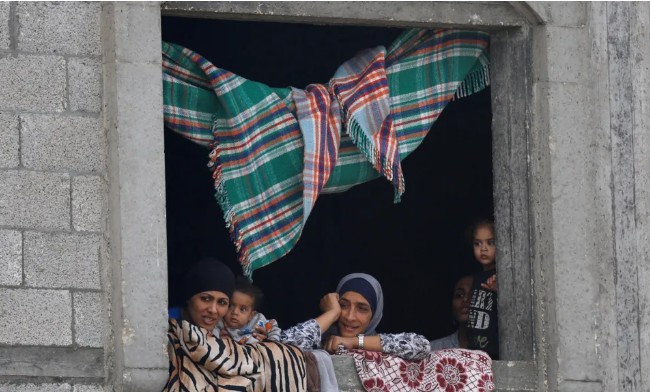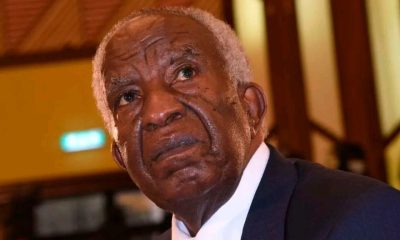World
Gaza Ceasefire: What We Know About The Gaza Ceasefire Deal
It comes two years and two days after the Hamas-led attack on southern Israel on 7 October 2023, in which about 1,200 people were killed and 251 others taken hostage.

After three days of intense indirect negotiations in Egypt, US President Donald Trump says Israel and Hamas have “signed off on the first phase” of the 20-point peace plan he unveiled last week.
“This means that ALL of the Hostages will be released very soon, and Israel will withdraw their Troops to an agreed upon line as the first steps toward a Strong, Durable, and Everlasting Peace,” he posted on social media, without providing further details about what the first phase entails.
It comes two years and two days after the Hamas-led attack on southern Israel on 7 October 2023, in which about 1,200 people were killed and 251 others taken hostage.
This triggered a massive Israeli military offensive in Gaza, which has killed more than 67,100 people, according to the territory’s Hamas-run health ministry. Its figures are seen as accurate by the UN and other international bodies.
Israel’s government approved the Gaza ceasefire and hostage release plan early on Friday, Israeli Prime Minister Benjamin Netanyahu’s office said in a statement.
This is what we know.
What has been agreed?
Now the agreement has been formally approved by the Israeli cabinet, a ceasefire is expected to take effect. Reports in Israeli media suggest this will happen immediately, although a spokesperson for the prime minister’s office said it would begin within 24 hours of the cabinet’s approval.
The Israeli military will withdraw to a line that will leave it in control of about 53% of the Strip, the spokesperson said. According to a map distributed by the White House last week, this is the first of three stages of Israeli withdrawal.
The Israeli military said on Thursday that preparations were under way to “transition to adjusted deployment lines soon”.
After this, a 72-hour countdown will begin during which Hamas must release all 20 of the hostages believed to be alive. The return of the bodies of the 28 deceased hostages would follow, although it is not clear how long that could take.
Israel would then release about 250 Palestinian prisoners serving life sentences in Israeli jails and 1,700 detainees from Gaza, a Palestinian source told the BBC. Their identities are currently unclear, but a list submitted by Hamas before the agreement was reached included high-profile figures serving multiple life sentences for deadly attacks on Israelis.
One of the most high-profile prisoners, Marwan Barghouti, will not be released as part of the swap, according to the Israeli spokesperson.
Israel will also return the bodies of 15 Gazans for the remains of each Israeli hostage, according to Trump’s plan.
Hundreds of lorries carrying humanitarian aid will also start entering Gaza, where a famine was confirmed by UN-backed experts in August.
Trump’s plan specified that 600 lorry loads would be delivered each day, but Palestinian sources said there would initially be a daily minimum of 400, with the number increasing gradually after that.
A multinational force of around 200 troops overseen by the US military will monitor the Gaza ceasefire, according to a senior US official.
The force’s makeup is likely to include troops from Egypt, Qatar, Turkey and the UAE. The official said their role would be to “oversee, observe [and] make sure there are no violations or incursions” of the ceasefire in Gaza.
A second senior US official said no US forces would be on the ground in Gaza.
What happens next?
If completed, the first phase of Trump’s 20-point plan would be followed by negotiations over the details of the later phases – but many of these points could be hard to reach an agreement on.
The proposal, which you can read in full here, says that if it is agreed by both sides, the war would “immediately end”.
It says Gaza would be demilitarised and all “military, terror and offensive infrastructure” would be destroyed.
It also says Gaza would be governed by a temporary transitional committee of Palestinian technocrats – supervised by a “Board of Peace” headed and chaired by Donald Trump and involving former UK Prime Minister Tony Blair.
Governance of the Strip would eventually be handed over to the Palestinian Authority, once it has been reformed.
Hamas would have no future role in the governance of Gaza, directly or indirectly, according to the plan.
Hamas members would be offered amnesty if they committed to peaceful co-existence or be provided safe passage to another country.
No Palestinians would be forced to leave Gaza and those who wished to leave would be free to return.
A “Trump economic development plan to rebuild and energise Gaza” would be created by a panel of experts.
What are the sticking points over the later phases?
But there are likely to be multiple points of contention during the negotiations over later phases of the deal.
Hamas has previously refused to lay down its weapons, saying it would only do so once a Palestinian state has been established.
The group also made no mention of disarming in its initial response to the plan last weekend, fuelling speculation that its position has not changed.
And although Israel agreed to the plan in full, Netanyahu appeared to push back on involvement of the PA in post-war Gaza even as he stood on the podium next to the president last week, insisting it would play no role in governing the territory.
Hamas has also said it expects to have some future role in Gaza as part of “a unified Palestinian movement”.
Another sticking point is the extent of Israeli troop withdrawal. Israel says its first withdrawal will see it retaining control of around 53% of Gaza. The White House plan indicates further withdrawals to around 40%, then 15%.
That final stage would be a “security perimeter” that would “remain until Gaza is properly secure from any resurgent terror threat”.
The wording here is vague and gives no clear timeline for full Israeli withdrawal – something Hamas is likely to want clarity on.
(BBC)
Kenya Insights allows guest blogging, if you want to be published on Kenya’s most authoritative and accurate blog, have an expose, news TIPS, story angles, human interest stories, drop us an email on [email protected] or via Telegram
-

 Business7 days ago
Business7 days agoKakuzi Investors Face Massive Loss as Land Commission Drops Bombshell Order to Surrender Quarter of Productive Estate
-

 Investigations1 week ago
Investigations1 week agoINSIDER LEAK REVEALS ROT AT KWS TOP EXECUTIVES
-

 Investigations5 days ago
Investigations5 days agoCNN Reveals Massive Killings, Secret Graves In Tanzania and Coverup By the Govt
-

 Business7 days ago
Business7 days agoBANKS BETRAYAL: How Equity Bank Allegedly Helped Thieves Loot Sh10 Million From Family’s Savings in Lightning Fast Court Scam
-

 News1 week ago
News1 week agoEXPOSED: How Tycoon Munga, State Officials, Chinese Firm Stalled A Sh3.9 Trillion Coal Treasure In Kitui
-

 News1 week ago
News1 week agoEx-Boyfriend Withdraws Explosive Petition to Remove DPP After Criminal Case Against Capital FM Boss Resurfaces
-

 Business22 hours ago
Business22 hours agoConstruction Of Stalled Yaya Center Block Resumes After More Than 3 Decades and The Concrete Story Behind It
-

 Politics6 days ago
Politics6 days agoI Had Warned Raila Of Possible Fallout In The Odinga Family After His Death, Oburu Says



















